
Chinese used to say a mountain is famous not for its height but for its holiness. Jiuhuashan (九华山), the popular Buddhist pilgrimages destination, is one of the 4 sacred mountains of China. It has high reputation in South East Asia, South Korea and Japan, not only due to its exclusively attractive scenery but also its abundant Buddhist Culture and legendary history. The mountain consists of 99 peaks in various sizes and shapes with 79 well-preserved temples, housing 6000 Buddha images. During golden period of Ming and Qing Dynasties, there were as many as 360 Temples and 4-5 thousand resident monks and nuns. Jiuhuashan is well known for its significance with collections of 2000 artifacts, 500 poems written by ancient poets of past centuries and 20 school of cultural relics including Buddhist scriptures and musical instruments. Most Mahayana Buddhists believe that it was the place where King of Ksitigarbha (Earth Store Boddhisattva) dwelt in his lifetime.


Jiuhuashan, originally known as Mt Jiuzi 九子山 was renamed to the present name as "Mountain of Nine Lotus" after famous poet Libai 李白 from Tang Dynasty 唐朝 wrote a poem about the mountains. He was highly inspired and intoxicated with the scenery during his visit. He admired the nine peaks and described them as nine lotus as if glories generated from the sacred mountain.



Jiuhuashan obtained its fame after Libai's poem, attracting visits of literates and scholars through several dynasties.




Jiuhuashan is situated at south east side of Chizhou City at Anhui Province 安徽池州, covering a gross land area of about 120 sq.km., with enchanting scenery and grand scale of temples and nunneries, magnificent in architecture and unique style.2


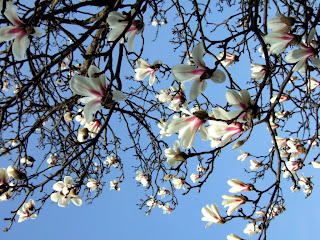
Scenery keeps varying with season changes.



The Corporeal Body Hall 肉身殿 at Yueshen Bao Dian housed the body of Rev. Kim Qiaoque. He was fully covered with gold leaf and seated in the prayer. Rev. Kim was a silla prince from Qingzhou of South Korea who came to Jiuhuashan for Buddhist cultivation and retreat in 719 AD. He never left the place since then. When he died at the age of 99, his body stayed intact. Local monks believed that he was reincarnated from King of Ksitigarbha (Dizang or Earth Store Boddhisattva in Chinese 地藏王菩萨).


Air was especially heavy with smoke of burning incense at the iron tripod outside Yueshen Precious Hall 月身宝殿. Many of Jiuhuashan's shrines and temples are dedicated to Earth Store Boddhisattva as since 8th century, Jiuhuashan had become a place to hold religious rites to worship for Earth Store Boddhisattva.


According to Mahayana Buddhism, Dizang is a Boddhisattva and protector of beings in hell realms. He vowed that if hells are not empty, he will not become a Buddha and that when only living beings have all been saved, he will only attain to Buddhahood.


I made a vow that I would kneel and bow to this great Boddhisattva in Mahayana way 108 times if I am to be in Jiuhuashan. I did it and fulfilled my vow in this Corporeal Body Hall.

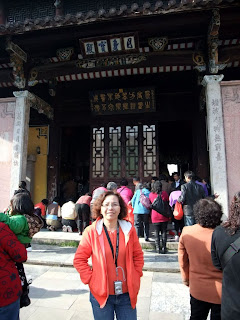

Buddhist Devotees from South Korea with the lead of a monk, kneel and bowed with head down after each recitation of Earth Store Buddhasattva's name. They did it 108 times.



The seven storey wooden Pagoda of Thousand Buddhas has a height of 17 meter. Each storey enshrined with eight gilded statues of Earth Store Boddhisattva in sitting posture with complacent look. The foundation of Pagoda is also the Altar of the shrine which was fully made of marble.



There are 81 stone steps from the hall front. We were blessed to have a Hubei young monk accompanied and benefited from his Dharma talk along the way with him.



Shrines and temples are amidst the dense woods and richly variegated landscape.



Bowing to Medicine Buddha and Boddhisattva Guan Yin.



Original name of Temple Hui-xiang Ge 回香阁 was Huayan Temple. In olden days, this was the only route going up Tiantai Peak, thus, it became the place to burn and offer the first and last incense. Gradually, people named it as Hui-xiang Ge.


The Avatamsaka Precious hall 华严宝殿 was an ancient building, restored in Ming and Qing Dynasties like many of temples in the mountain.


North west of Tongya Temple 东崖禅寺 was a 10 feet two storey pavilion built on a huge stone projecting on the peak of a cliff like a mighty dragon raising his head towards heaven. Dongyan Anzuo 东岩安坐 is one of the ancient sights. When mounted on the rock and look around, the whole mountain is within the sights.



It was said that when Monk Ti-Tsang first came to Jiuhuashan, he often sat himself comfortably on this stone and intoned Sutras while enjoying the sights. Many literates later followed him with respect and left numerous poems and essays with the block of rock as the subject. Among those poems "East Rock" was the most famous. It reads " Retreat alone in the deep of cloud, see the East Cliff distinguished from the crowd, Like beauty veiled amidst the smoke, as though lotus blossom in the sky, In the dense woods the golden temple hides, the mountain echoes when bell sounds in the empty vales, Those high minded sit with delight, no immortals shall ever be traced."


Up hill to east peak is accessible by a 10 minutes tram car ride at a fare of rmb55.00 each way each person or by foot to walk up along the ridges through the steep path.


The glory peach plants and pine trees at hill top in this early spring time.


The 120 sq km of mountainous land are full of ridges, peaks, streams, waterfalls and exotic-shaped stones. Beautiful scenery and favorite climate make the sacred place also a summer resort.


Along the pathway to Baisuigong, there were locks hanging every corners. I wandered what were they locking! Was it love or wealth or longevity or perhaps promises? Could it be the faith in heart or the blessing from Boddhisattva? Was there any one locking their monkey jumping mind? We would like to, if possible.



Wanian Temple 万年禅寺 commonly known as Baisuigong (百岁宫100 years palace) was originally built in Ming Dynasty. It was said that an eminent Monk named Wuxia after visiting Mt Wutai and Emei, came to Jiuhuashan for hard practice of Buddhism. He compiled a complete set of Great Avatamsaka Sutra using his blood with gold powder in a cave. He died at an age of 126 and the body was found three years later after his death, perfectly preserved. Locals were amazed and built a temple giving a name as Zai-Xing An to place his body and worship. In 1603, Emperor Chongzhen of Ming Dynasty honored him as "Reincarnated Boddhisattva 应身菩萨".


Disciple of Monk Wuxia later expanded the temple and renamed the temple as Wanian Temple. Body of his master covered in gold leaf, with a vermilion robe and lotus flower shaped crown seated in the prayer, still very well preserved after more than 350 years.



Baisuigong is the 4th largest temple site at the mountain and one of the temples that most Buddhist devotees are keen to pay homage.




A few steps away from Wanian Temple, stand a beautiful structure of Five Hundred Arahants' Hall 五百罗汉堂.



Buddhist Teaching emphasize a lot on The Four Noble Truths: Suffering, Origin of Suffering, Cessation of Suffering and the Path to Cessation of Suffering. The inscription board written in Chinese calligraphy The Four Noble Truths at the top edge of each entrance door attract as much attention as the 500 images of Arahants seated in the hall.

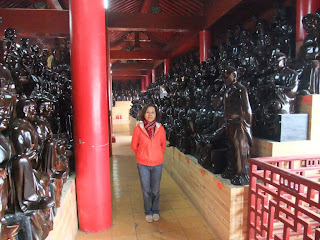

An ancient well fountain and a simple iron board reminding visitors not to pluck the flowers as she needs to say hello to others. The verse stated therein is much effective than a warning phrase of getting fined by cash.


The mountain appears like a face image of sleeping Buddha, viewed from the spot where the two peacocks are. While admiring the natural face image of The Buddha, I had few pieces of tofu and an egg as my lunch, simple and tasty.



Shang-Chan Tang 上禅堂 was firstly constructed in Ming Dynasty under an original name of Jingte Tang. It was renamed to the present one in 1667 when the temple was renovated. The temple was described in the olden days to be the most scenic in environment, the most elegant in structure and the least in followers. The Hui architecture of Qing Dynasty still reflected in some of the remaining buildings at the temple complex.



During the reign of Emperor Qianlong in Qing Dynasty, the abbot included in the temple complex, a hall for Boddhisattva GuanYi followed by an Holy Dew Guan Yin Pavilion in 1920. The famous sites here are the Gold Sand fountain and Money tree which was said to be transformed from the money notes dropped by Poet Libai.


Group of yellow colored nunneries 群庵尼园 nested under the foot of Tiantai Peak, like a beautiful landscape painting.




A serene and peaceful condition for cultivation!






Nunneries amidst in the mountain valley with ancient Hui architecture and bright color, attracted groups of artists to make illustration on its beautiful landscape.









The Phoenix Pine with a height of 7.2 meter and 3.1 meter in girth, boasts to be number one pine tree on land under heaven. Its verdant foliage, flat and scaly twin trunks form looks like a green phoenix craving its neck ready to fly towards sky. It was planted by a Buddhist monk named Zhedu during Nanbei Dynasty南北朝 (North South period) about 1400 years ago.




Phoenix pine stands at an attractive landscape by the path that threads its way through sea of bamboo.



A surprising sight! Along the short distance pathway between Tiantai Temple and group of nunneries, there were hundreds and hundreds of chickens, salted and exposed under natural air. According to the local guy we chat with, this was their living and preserved salted chicken is their local delicacy.


Although chickens were hanging at every space of the quarters, majority of restaurants offer vegetarian meals as mountain produces large volume of wild fungus, mushroom and vegetables.




The most uncomfortable scene especially at the sacred place of Buddhism which emphasize so much on non-killing.


O Mi Tuo Fo 阿弥陀佛 for the hanged poultry. May they have a good rebirth after this.



Green peas, bamboo shoot and all kinds of fungus are the products from the mountain sites



Tiantai Temple 天台寺 stands on the top of Tiantai Peak, 1306 meter above sea level. It occupies a total area of 1540 sq meter sitting across the dent formed by two hills. Dizang Monastery at Tiantai Peak also has a Corporeal Body Hall that housed the body of another monk named Ci-ming. The Sutra worship platform 古拜经台 (Gu-bai-Jin Tai) at Buddhisattva's Domain was said to be the actual place Rev. Kim, the Korean Monk, did his meditation and cultivation.


Splendor scenery at the foot hill and valley of Tiantai mountain ranges.


Tiantian Peak is accessible by cable cars but during weekends or public holidays, the queue will take you hours to just get in the cable cars.m




Tiantai Passenger transport rope way goes 1500 meter between Mingyuan and Tiantai Scenic sports, where monasteries and nunneries nested behind the trees in the slopes or valleys.




While most adults were enjoying their meals in farmers' house, kids were attracted by the ground water from stream, and we were waiting in front of the transport office to hitch for buses to go downhill back to Jiuhua town.


Short distance away from Longhua Temple Complex 龙华寺 along the main street, is the building of Jiuhuashan's oldest temple, Huacheng Temple 化城寺 which is nested in the valley of Huacheng ranges at Jiuhua Old Street., Huacheng Temple is actually A Buddhist Cultural Exhibition Hall. It holds under its simple and solemn structure, large scale and collections of precious Sutras and cultural relics. The engravings on the roofs, brackets and lintels are artistic and the 9 dragons playing with pearls 九龙戏珠 at the main shrine was a piece of true art.


A large liberation pond in front of Huacheng Temple.


Due to cold weather, many of the gold fish released in the liberation pond were dying.



Stroll along Jiuhua Old Street is the most pleasant and comfortable thing to do in Jiuhuashan. While admiring the scenery, enjoy the shopping.


Excessive varieties of local products like Yellow Ginger, stone fungus, wild mushroom, herbs and dried vegetables are available from rows of shops at Jiuhua Old Street.


Most of the shops at Jiuhua Old Street are in the style of Hui's architectural.



Nuns were heading for Buddhists Assembly at Zhantanling Temple.
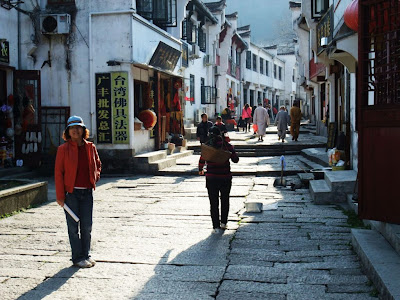

Qiyuan Temple 祗园寺 was first constructed in Jiaqin reigning period in Qing Dynasty.


The massive figure of Hensanshi Buddha worshiped in the temple is the biggest image at mountain.



Leaned against Dongya Hill and faced Tiger Hill along the main street, Qiyuan Temple is a key temple with palace-like building structure with halls overlapping halls, with palaces and courts delicately connected.



Tonghui Temple 通慧禅林 is a nunnery and it house the body of Nun Renyi at prayer. I bowed and sincerely paid the homage to her with my great respect as it was not easy for a nun to have such achievement in Buddhist cultivation. This is also the only hall that visitors were requested to change to temple shoes when doing respect to the nun.


Jiuhua main street was rather bustling in weekends when locals came for praying and attending assembly.


Zhantanlin 旃檀林 sits below Baisuigong Temple 百岁宫 with steep pathway connecting each other.



Zhantanlin Temple Complex 旃檀林 located at south west of Jiuhua main road was initially built during the reign of Qing Emperor Kangxi (1662-1772) but was destroyed in war during the reign of Emperor Xianfeng. The temple complex was rebuilt in 1886 and with several renovation and expansion in early 20th century till today's scheme. It covers a building area of almost 3000 sq. meter.


The Temple was named as Zhantanlin which means temples of Sandal Wood. When it was first started to build, the monks used the old tree trunks from the nearby mountains and found that the wood was hard with beautiful texture and with fragrance. Thus applied the tree's name as the temple's name.22


Hundred of monks in their bright red robes were in the Buddhist Assembly for Qing-Ming Festival.


Daxiong Bao Dian (Main Shrine), Dabeilou 大悲楼 and Dayanlou 大愿楼 are the three major halls starting building in 1990, followed the traditional style in construction structure.



Traditionally ornamented Halls of Zhantanlin .



The main street is fully occupied by stalls selling incense and praying items and also suppliers of herbs and dried food products.


Most of the restaurants displayed their food in front of the shops. Clay pots consisted of simmered meat dishes in local herbs while on the trays were various raw fungus, wild mushroom and vegetables (to be cooked upon order). We had vegetarian meals and tried on their fermented tofu, which were not too bad to taste when stir fried with vegetables.



Visitors who had obtained the entrance ticket at RMB190.00 were offered with free yellow bus services travel regularly up and down the hill and also from one scenic spot to another.



Foot hill bus stations at tourists service center in the morning sun. All tickets counters are inside the building including the long distance buses for inter-states.
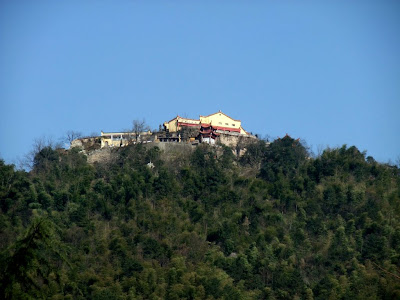

No comments:
Post a Comment